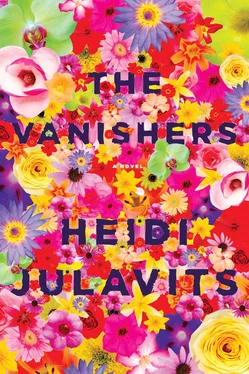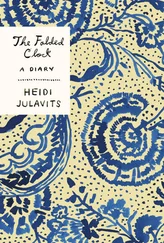“ There you are,” said Alwyn, as though we hadn’t agreed yesterday to meet exactly here.
“This is Colophon,” she said, presenting a drawn man who most resembled, of the famous people I could think of, Virginia Woolf. He wore a gray suit beneath a gray overcoat, and could have passed for an overworked diplomat were it not for the felt beanie on his head.
Colophon announced that he was hungry and needed to eat. He did not appear interested in me, save to discover whether or not I was a fan of gnocchi.
Fine, I thought. We could be mutually indifferent to each other.
Alwyn insisted on charging my bar tab to her room. I left Irenke a napkin note that said, “You vanished. I’m off to eat Italian. I’ll call on you.” Of course Irenke hadn’t given me her phone number, but I hoped she’d figure that I was drunk and forgot I had no way to contact her. Because the truth was this, I told myself: I was never going to call.

At the restaurant, Alwyn filled and refilled her tiny wineglass with Chianti, and occupied herself by holding the corners of her polyester napkin in the candle flame, watching the fabric wither to a nub. After we ordered our food, she engineered a tiff with Colophon.
“Did you mail the grant application?” she asked.
Colophon confirmed that he had mailed the grant application.
“Because it had to be postmarked by today,” Alwyn said.
Colophon repeated that he had mailed the application.
“You always insist that postmarks don’t matter,” Alwyn said, “but I assure you that the committee is dying for a reason to throw your application in the trash.”
“We’ve applied to Timothy Kincaid’s foundation for a research grant,” Colophon explained. His voice was subterranean and minor-keyed, mellow but not altogether relaxed.
Not that I wanted to sleep with him, but — I could sort of understand why Alwyn did.
“ We are not trying to get a grant,” Alwyn said.
“I am trying to get a grant and Alwyn, though she does not agree with my Varga theory — that her acts of political and professional immorality were performance pieces meant to critique such political and professional immoralities — will nonetheless benefit from the funding as my research assistant,” Colophon explained.
“Porn is porn,” Alwyn said. “Authorial intent does not make it less porny. That was her point.”
“And what was your authorial intent?” Colophon asked. Then to me: “Alwyn had quite a porn career once upon a time.”
“I don’t know if I’d call it a career,” she said. “More of an inspired hobby.”
“Not so inspired,” Colophon said. “How familiar are you with Dominique Varga?” he said to me, cutting to the chase. Colophon, I’d already registered, was not one for small talk unless it, too, was of the cutting variety.
“Not very,” I said.
As Alwyn continued to drain glass after tiny glass of Chianti, Colophon told me all that I already knew, and much that I did not, about Dominique Varga. Born in 1942 to a Hungarian mother and a French father, Varga began her career as a morgue photographer in Paris, where she’d moved from Budapest in the late sixties at the age of twenty-six. One day Varga took a razor blade to the photographs she’d snapped of the female cadavers, excising them from their morgue surroundings. She pasted these into the editorial spreads of fashion magazines on the metro newsstands, situating them alongside the models like dead alter egos. When Varga was arrested and charged with vandalism, her career was born.
“From the very outset, however,” Colophon said, “she positioned herself as an artist with a contradictory, even hostile belief system.”
When Varga’s work was championed by French feminist critics Simone Moreault and Lisette Bloch, for example, Varga responded by wearing funeral attire to the trial of Jules Fanon (a then-infamous dismemberer of prostitutes) and weeping on the courthouse steps for seventy-two straight hours following Fanon’s sentencing to life in prison. Later she published a series of domestic photographs titled “Interior ReDecorator” wherein she simulated a self-administered abortion with a curtain rod; obscuring her head is a large photograph of “Let Them Live,” the French 1970s anti-abortion group.
But according to Varga — a claim her oft-mocked critics, Colophon said, met with forgivable dubiousness — her cruelly whimsical attitude changed overnight when, in 1977, her mother died. After selling all of her belongings, including her prints and her negatives, and donating the proceeds to a political collective intent on installing the death penalty in France, she withdrew from the art scene for two years. By the time she reappeared, in 1979, she’d become one of the most prominent directors of underground pornographic films in Europe.
Yet the word pornographic , Colophon explained, didn’t accurately capture the tenor of these films, which were less erotic than meditative, even serene. The films gained a fringe cachet among louche, aristocratic Europeans, in particular a wayward heiress who organized, at her Ibiza beach house, the first official festival dedicated to Varga’s films, in June 1980. The second night of the festival, the heiress disappeared.
“Like vanished?” I asked.
“Like dead,” Alwyn interjected.
“Or possibly not,” Colophon said.
“Dead,” Alwyn repeated, bored.
A month later, a gossip columnist in Paris received an anonymous phone call informing him of the existence of a film directed by Varga, one that starred the heiress lying on an Ibiza roadside. Her car, crunched against a cliff, smoked in the background as her body, thrown (or dragged) free of the wreckage, was lovingly fondled by masked women wielding prosthetic hands.
While many in the heiress’s circle claimed to have seen this film, Colophon said, no hard copies were ever recovered. Soon, however, a series of six snuff films bearing Varga’s signature dark aquarium lighting began circulating, again via underground channels, throughout Europe. Though no bodies were found, Varga was charged with the murder of the heiress and six other women. But at her sentencing, a female spectator removed her coat and lay, naked, in the aisles of the courtroom. Once in custody, the woman identified herself as the “snuffed” star of Varga’s six films.
“Nobody died during the making of these films,” Alwyn said, quoting Varga. “Nobody but me.”
Following her acquittal, Colophon said, Varga again found herself both embraced and reviled by the French feminist establishment. Those who reviled her were invited by Varga to her film premieres and asked to speak to the audience about Varga’s moral flaws while Varga wept audibly backstage. Those who persisted in supporting her, such as Simone Moreault, found themselves mercilessly parodied.
“She made a film called Simone Moreault ,” Colophon said, “in which a badly dressed academic uses a naked woman as a typewriter stand.”
In 1982, criticism erupted over a series of films showing Varga having sex with young male artists who, afterward, professed to have slept with her only to gain a career foothold. None of these men knew they were being filmed. The results were exhibited in a show Varga curated at Blue Days, her then-gallery in Paris, called “Up-and-Comers, Coming, Going.”
“Varga claimed, ‘My grieving body is the most powerful sculpture any of them will ever create,’ ” Colophon said. “And here is where my scholarly interest in Varga begins.”
According to photographs of this opening, an anti-fascist artist named Cortez was among the guests. Two weeks later, Varga announced she’d accepted an endowed chair at the Institut Physique du Globe de Paris; additionally, she’d been hired to shoot a propaganda film for Jean-Marie Le Pen and his Front National party that would, Varga said, “make Triumph of the Will look like a Looney Tunes animation,” a claim that earned her the nickname, “the Leni Riefenstahl of France.”
Читать дальше













